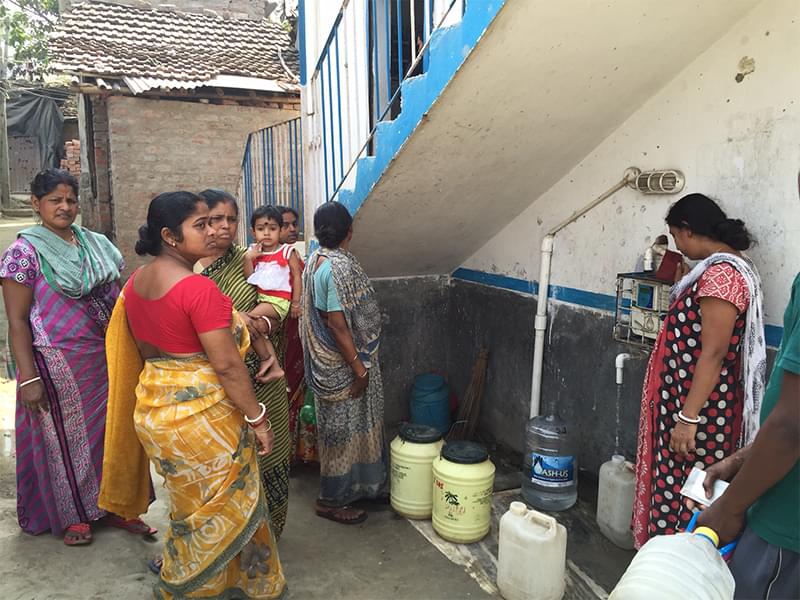Opinions
Kolkata: Smart Women use Smart Cards for Safe Water and to Save Water

“What more could we ask for! We have finally got to drink water that is adequate, clean and safe”, says twenty year old Rinki Shaw of No 3, Kallikapur slum on the Eastern Metropolitan Bypass in Kolkata. She has been using a smart card for the last two years to collect ten litres of safe clean drinking water every morning for herself and her family from the local tap affixed to an automatic water dispensing machine (ADU) in her urban slum.
Despite living beside the huge pond located at about hundred and fifty acres of wetlands, the young urban slum dweller of ward number 108 and 109 under the Kolkata Municipal Corporation, is among the five hundred and sixty odd families who dealt with severe scarcity for adequate drinking water. Now that they use the water ATMs as it is popularly known, smart cards fetch them their share of free ten litres of clean and safe drinking water daily. Also for additional requirements they top- up their cards with some money and fetch more water as and when required.
Drinking water has always been the biggest challenge for the women in the urban Kallikapur slum located in between the many high rise apartment complexes of the city. The women as the practice goes served as the sole arranger for the daily drinking water in the family and her primary job had been to collect water from wherever it was available. They would wake up early, reach the nearest hand pump first thing first in the morning, queue up faster so as to fill in their drums with water and carry them back home to store. But most days were extremely bad. Either the hand pump went dry or there would be no supply water in the municipal tap or other household jobs would delay one or the other. Also many times their stored water conveniently sheltered mosquitos and other carriers for several diseases in their dingy homes.
Now with the availability of the smart cards these women have otherwise turned smarter. They queue up near the ADUs daily in the morning conversing casually with neighbors waiting for their turns or any other time as per their convenience to take home their share of the ten litres of free drinking water for their family without getting worried that the water will get over. Also now that there is a quota of water allotted to each family they know how to save water so that they do not have to buy more.
The water comes out from a filter water plant built with technical support from a non-governmental science and environment organization SAFE (South Asian Forum for Environment) that works on developing a sustainable environment and poverty alleviation. “It is a revolutionizing measure. We spent three to four hours daily collecting water that took away most of our time. We could not work, take care of kids or do household work because at the back of our minds it was always collecting water the first priority. Now with the smart cards, we do not have to worry about the minimal need in the house ie safe and clean drinking water that does not let me and my children fall ill frequently”, elaborates Kavita Pal, a member of the community leading the joint liability group (JLG) and in-charge for monitoring and the upkeep of the filter plant supplying water.
The water filter plant was built in partnership of the community and the NGO supported by the international funding agency HSBC’s Water Program that provided the initial funding and technical support for the sustainable model project. “In fact this has been an ambitious comprehensive model on water and sanitation that utilizes carbon smart energy and climate adaptive usage of water resources effectively”, “the success of this model project has been many folds quite visible in the slum”, explains Amrita Chatterjee, Director Communications and Research of the South Asian Forum for Environment (SAFE). “It was a pilot project and is complementary of many other things in the community. The water primarily taken from the nearby pond is filtered in the filter plant that is built on the community land. The refused water is reused in the community toilets. The toilets are connected to a biogas plant that serves fuel to the community kitchen. And finally the filter plants runs of solar energy by the grid on the roof of the plant house”, she explains.
The project has gradually and finally attained self- sustainability after almost two years. The room that houses the filter plant has huge solar grid that produces more than 10 KW of energy to run the filter plant. The water is supplied from the first level of aquifer water through underground channels from the nearby pond. Surface water from the pond is not used as people have inhibitions in drinking the dirty water that they use for cleaning and washing purposes. The filter plant filters about 10000 litres of water daily for the residents that people collect every day from the three dispensers affixed in three locations in the slum. The ten litres of water come free from the smart card that people have but if they need more water they buy it by topping up their cards with money to buy more of the filtered water. For more water people pay fifty paise extra per litre for the extra share of water that they take. “The idea is to promote self- sustainability of the whole model. The money helps in the upkeep and maintenance of the plant. Guys of the community have learnt to keep the machines going. They were trained by engineers from the vendor Eureka Forbes who fixed the filter machines. The upkeep and the maintenance is being borne by the community itself”, explains Rabi Kumar Jana who works as the manager of the filter plants, the community toilets, the bio gas unit and the community kitchens.
The refused water whose percentage was more than thirty to forty percent initially has gone down with better upkeep of the water filter plant. The refuse water is effectively reused in the twenty four community bio -toilets that have been built by the people as a part of the project in the area. “It is a unique experience as the community toilets make up the biogas plant that provides fuel for the community kitchen as well”, he adds.
It was through a study by the World Bank that had estimated poor quality of drinking water causing 21%of diseases in India and creating the burden of around 300 crore rupees every year on the government for health services that motivated the NGO SAFE to plan the project for this urban slum in Kolkata. India spends about 1,48,000crore rupees every year since 1990s in the Water Sanitation Hygiene project but still the country ranks 120th in a survey of 123 nations on ‘safe water index’ conducted by UNDP. UNDP’s report identified the toughest health challenges among the dwellers of urban slums who became victims of environmental pollution, poor sanitary services and contaminated drinking water.
This project now successfully addresses basic healthcare and sanitation issues by providing safe drinking water to infants and mothers and sanitation and hygiene facilities by effectively planning the use of solar energy, bio gas plants and community kitchens. The community kitchens on the other hand, have been tied with local schools that provide mid -day meals thus helping in generating funds for the community. The project is being replicated in two other urban slums in Kolkata now that the sustainability of the project has been measured and recognized by UN for best Practices in water and sanitation.
“Also men have now got involved. Earlier they thought collecting water, cleaning toilets and making food in kitchen was all women’s work. But with community ownership the men and women have together taken the lead and work side by side” says Rina Jana confidently another beneficiary of the project.
